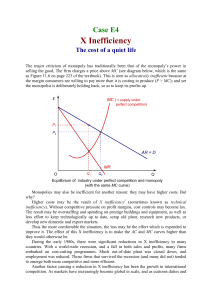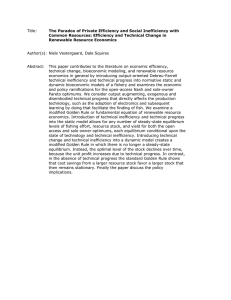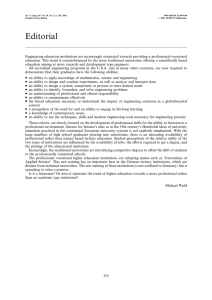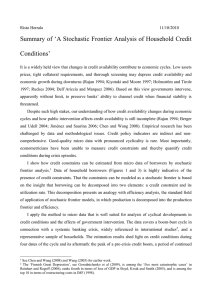Document 13724303
advertisement
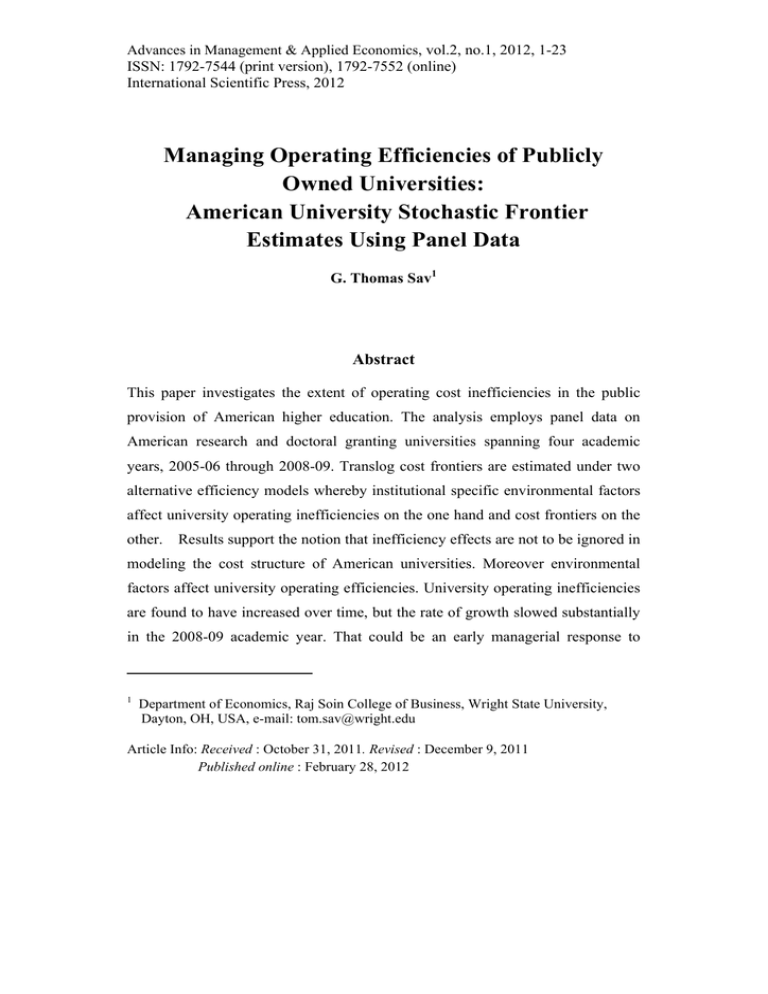
Advances in Management & Applied Economics, vol.2, no.1, 2012, 1-23 ISSN: 1792-7544 (print version), 1792-7552 (online) International Scientific Press, 2012 Managing Operating Efficiencies of Publicly Owned Universities: American University Stochastic Frontier Estimates Using Panel Data G. Thomas Sav1 Abstract This paper investigates the extent of operating cost inefficiencies in the public provision of American higher education. The analysis employs panel data on American research and doctoral granting universities spanning four academic years, 2005-06 through 2008-09. Translog cost frontiers are estimated under two alternative efficiency models whereby institutional specific environmental factors affect university operating inefficiencies on the one hand and cost frontiers on the other. Results support the notion that inefficiency effects are not to be ignored in modeling the cost structure of American universities. Moreover environmental factors affect university operating efficiencies. University operating inefficiencies are found to have increased over time, but the rate of growth slowed substantially in the 2008-09 academic year. That could be an early managerial response to 1 Department of Economics, Raj Soin College of Business, Wright State University, Dayton, OH, USA, e-mail: tom.sav@wright.edu Article Info: Received : October 31, 2011. Revised : December 9, 2011 Published online : February 28, 2012 2 Managing Operating Efficiencies of Public Universities... budget cuts driven by the financial crisis. Rankings based on individual university performance indicate fairly wide inefficiency variability and some flagship universities residing among the more inefficient institutions. With growing interest in public management reform, the paper should be of interest from both perspectives of public policy and managerial decision-making. JEL classification numbers: I21, I22, I23, L3, C33 Keywords: Cost Frontier, Public Universities, Cost Inefficiencies 1 Introduction Public deficits and increasing debts induced by the financial crisis and the so-called Great Recession have accelerated international interest in public management reform and the call for greater efficiency in the delivery of publicly produced goods. In the United States, publicly funded universities have not escaped either political or taxpayer scrutiny or the managerial realization of the need to make internal restructuring decisions, all of which appears to be occurring in the absence of rigorous empirical study and evidence regarding the extent to which there exists university operating inefficiencies. Yet, stochastic frontier analysis offers a robust methodological approach to the measurement of operating efficiencies at the industry, sector, and firm or institution level. The methodology has been fruitfully applied in obtaining efficiency measures within a variety of industries and sectors. It involves the basic concept that a firm’s production and costs, while at the peril of uncontrollable random shocks driven by such things as catastrophic weather events and economy wide recessions, can also be generated from inefficiencies that are due to characteristics of inputs or managerial performance. Thus, the main thrust is that these inefficiencies cause firms to operate below their stochastically maximum production or above their minimum G. Thomas Sav 3 obtainable costs. It is the purpose of this paper to determine whether or not and to what extent there exist such operating cost inefficiencies in the American provision of public higher education. The focus is on Carnegie classified American doctoral and research universities that engage in the delivery of multi products, including undergraduate, graduate, and professional school education along with research. The university multiproduct cost frontier is estimated via a translog cost function using panel data pertaining to 159 institutions over four academic years, 2005-09. Hence, there is the possibility of uncovering the presence of initial university operating responses to the financial crisis. In addition to providing time varying inefficiencies over academic years, inefficiency scores and rankings are presented for individual universities. An exhaustive literature survey indicates that the research represents the first known application in employing stochastic frontier analysis in investigating operating cost efficiencies of American universities. 2 Applied Literature Efficiency estimates based on stochastic frontier analysis are rooted either in production or costs. The stochastic production frontiers were pioneered by Aigner, et al. (1977) and Meeusen and van den Broeck (1977). Aigner, et al. made empirical application to the U.S. primary metals industry. Other applied studies followed suit with applications to U.S. dairies (Kumbhakar, et al., 1991), India paddy farms (Battese and Coelli, 1992 and 1995), international airlines (Coelli, et al., 1999), and U.S. electricity (Knittel, 2002). On the cost side, stochastic frontier research has embraced the U.S. airlines industry (Kumbhakar, 1991), insurance industry (Cummins and Weiss, 1992), hospital care (Bradford, et al., 2001), and banking (Huang and Wang, 2001), among others. Of particular interest in the present paper is the fairly new emergence of 4 Managing Operating Efficiencies of Public Universities... stochastic cost frontier applications to education. At the primary and secondary school levels, Chakraborty and Poggio (2008) examined the inefficiencies pertaining to Kansas school districts using panel data for 2001-05. In higher education, Izadi, et al. (2002) use 1994-95 data to estimate efficiencies for 99 British higher education institutions. Stevens (2005) provided a 1995-99 panel data study of 80 English and Welsh universities. Johnes and Johnes (2009) also employ panel data for a three year period, 2000-2001, in their study of 121 English institutions. McMillan and Chan (2006) did a 1992-93 cross section study of 45 Canadian universities. Abbott and Doucouliagos (2009) examined 7 New Zealand and 36 Australian universities from 1997 to 2003. Each of these higher education studies has used different cost and inefficiency specifications that make comparisons difficult at best. The study by Stevens (2005) represents the closest in methodology and data for comparison to the current study of American universities. 3 Cost Frontier and Efficiency Methodology To obtain empirical measures of university operating efficiencies, we rely on the stochastic frontier methodology developed by Aigner, Lovell, and Schmidt (1977) and Meeusen and van den Broech (1977) and extended, in particular, by Battese and Coelli (1992) and Battese and Coelli (1995). Following Kumbhakar and Lovell (2000) and Kumbhakar and Sarker (2005), given that universities produce multiple products and employ multiple inputs, the superiority of the stochastic cost frontier is chosen over the production frontier. For empirical implementation, the translog, with its well- known functional flexibility, is selected for the cost specification pertaining to American universities. Thus, for the multiproduct university, the annual operating costs, C, can be characterized by the following cost frontier G. Thomas Sav 5 ln C 0 j ln Q j k ln wk 12 jl ln Q j ln Ql 12 km ln wk ln wm j k j l k m kj ln wk ln Q j (v u ) k (1) j where, in the case of longitudinal data, the institutional i and time t subscripts are omitted for convenience and the standard coefficient ai , j a j ,i equalities prevail for , , and . In a broad sense, university outputs, Q, are generally thought of as including different levels of education and research. On the input side, universities are considerably labor intensive and the input prices, therefore, are usually wage rate, w, related. The specific Q outputs and w wage rates used in the empirical estimations are largely dependent upon data availability. For the present study, the data details are taken up in the next section of the paper. With institutional i and time t subscripts renewed for clarity, the cost specification error term ( vit uit ) is comprised of two components. First, there is the usual random error denoted here by vit ; it is assumed to be independently and identically normally distributed with zero mean and variance 2 : i.e., N (0, 2 ) . Second is the inefficiency component uit that is nonnegative and independently distributed. Thus, university operating costs are subject to random variations beyond direct administrative control but can also be the result of managerial and other factors creating inefficiencies and causing universities to operate above ( uit 0 ) their minimum cost frontier. Measuring whether or not and to what extent universities are inefficient in this sense rests on a number of assumptions. This paper proceeds with two alternative efficiency assumptions. Following that which is proposed by Battese and Coelli (1995), hereafter BC95, the managerial or so-called environmental factors, denoted by zit, are modeled as explicit determinants of the university’s inefficiency effect. Under this specification, uit zit xit (2) 6 Managing Operating Efficiencies of Public Universities... where zit is a (rx1) and is a (1xr) vector of coefficients with a constant term 0 included and xit is a random variable defined by the truncation of the normal distribution with zero mean and variance u 2 truncated at the point zit . Rather than entering the inefficiency component, the alternative Battese and Coelli (1992) model, hereafter BC92, assumes that the environmental factors alter the shape of the university’s cost frontier. In this case, the translog cost frontier specified by (1) would be amended to directly include zit (without 0 ). The inefficiencies can be defined by uit ui exp( (t T )) (3) Here, the ui are independently and identically distributed as truncations at zero of N ( , 2 ) . The inefficiency monotonically increases ( 0 ), decreases ( 0 ), or remains unchanged over time. Under both BC models, the estimation of the cost frontier will proceed with four university outputs and two input prices. There will be six environmental factors along with a time trend employed as determinants of inefficiency in (2) for the BC95 model and as cost frontier altering determinants in (1) for the BC92 model. Thus, the z’s are neither outputs nor input prices; they are a mix of environmental factors that have alternative ways of entering and subsequently affecting costs and operating efficiencies. 4 Panel Data University level data are drawn from the Integrated Postsecondary Education Data System (IPEDS) housed at the U.S. National Center for Education Statistics. The IPEDS annual survey instruments change over time, redefining and deleting variables, thereby creating difficulties for some longitudinal analyses. Using the most recent data releases, consistent panel observations on Carnegie doctoral and G. Thomas Sav 7 research classified public universities were available for four academic years, 2005-06 through 2008-09. Eliminating universities that failed to report any total cost or enrollment data produced a balanced panel of 159 universities. To model university costs, outputs and input prices, we rely to a large extent on the successes of previous research related to university cost structures, including the seminal work of Cohn, et al. (1989) and subsequent investigations by Koshal and Koshal (1999), Sav (2004), and Lenton (2008), among others. In that context, the academic year cost (C) incurred by universities is the reported total operating expenses. University outputs include undergraduate, graduate, and professional school education and research. Credit hour production over the academic year is the output measure for undergraduate (UG) and graduate (GRD) education. That accounts for students of different classifications (part and full-time) carrying different course loads throughout the normal academic year, intersessions, and summer months. That measure was unavailable for professional school (PRO) output. Instead, it was necessary to use head count enrollments. That, however, seems reasonable based on medical, dentistry, veterinarian, etc. professional schools being lock-step full-time student programs. Here as with previous studies, the proxy for a university’s aggregate research (RES) output rests on the receipt of government and private research grants, gifts, and contracts. The proxy has been widely accepted (e.g., references noted above) based on the unavailability of quality substitute measures and the notion that external funding support correlates highly with aggregate research output. On the input side, two wage variables are included: one representing teaching and research faculty and one representing administrative faculty. The two wages are proxied by average salaries, as is common to other cost research. Presently, faculty wages for teaching and research faculty use the IPEDS salaries for nine month contracted faculty (SAL9). Administrative faculty on twelve month contracts such as department chairs, deans, and provosts are assigned the IPEDS twelve month salary contracts (SAL12). 8 Managing Operating Efficiencies of Public Universities... Environmental factors included in the inefficiency effects are similar in spirit to those used by Stevens (2005) in studying English and Welsh universities. That is, student and faculty characteristics purportedly affect cost efficiencies. For the former, the university’s percentage of students funded by federally provided low income grants (FEDGRT) is used as a possible indicator of underprepared students coming from underfunded school districts. Also included is the percent of nonwhite students (NWHITE) with the notion that universities build special courses, programs, and centers related, e.g., to African American, Hispanic, and Asian experiences. Both enrollment increases could affect a university’s operating efficiency through the need to engage in remedial or supplementary education and to allocate resources to fostering educational diversity. The remaining four environmental factors relate to the university’s labor force characteristics and parallel a portion of the variables used in the studies by Chakraborty and Poggio (2008) and Abbott and Doucouliagos (2009), in addition to Stevens (2005). Included is the quantity of labor input allocated to the production of teaching and research and to administration. Teaching and research faculty are defined as the number of faculty employed on nine month contracts (FAC9). Administrative faculty are employed on twelve month contracts (FAC12). Similarly, university cost differences are likely to arise from differences in the percentage of faculty employed that are in non-tenure track (NTRACK) teaching positions. That measure includes both part-time adjuncts and non-tenure track instructors, both of which generally do not hold the Ph.D. and are not required to engage in research. In contrast, teaching-research faculty are either on tenure track appointments or have received tenure. To examine the effects on efficiency, the percentage of faculty that have received tenure (TENURE) is the included group. Of course, a priori it is difficult to hypothesize the efficiency effects of NTRACK and TENURE. On the one hand, it is a well- known claim that there can be direct cost savings realized in the employment of lower wage, non-tenure track G. Thomas Sav 9 faculty for the purpose of meeting institutional teaching needs. However, the substitution of non-tenure for tenure-track and eventually tenured faculty has the potential effect of reducing research funding that carries cost reducing effects through, e.g., graduate student research stipends and education and university overhead or administrative expenses. Other claims abound, including the notion that the tenure system creates inefficiencies due to so-called personnel inflexibilities imposed on managerial decision-making. That is widely refuted by other camps that welcome the cost saving efficiencies ingrained in the employment stability created by the tenure system. Either way, it is hoped that the present empirical results can help shed some light on the matter. Table 1 presents a summary of the variables along with their means and standard deviations. All dollars are in real 2009 year dollars, the most recent academic year of data available for this study. Table 1: University Variable Means and Standard Deviations Variable Total Operating Cost ($), C Undergraduate Credit Hours, UG Graduate Credit Hours, GRD Professional School Enrollment, PRO Research Grants ($), RES Salary of Nine Month Faculty ($), SAL9 Salary of Twelve Month ($), SAL12 Student Low Income Federal Grants, FEDGRT (%) Non-White Student Enrollments, NWHITE (%) Employment of Nine Month Faculty, FAC9 Employment of Twelve Month Faculty, FAC12 Non-Tenure Track Faculty, NTRACK (%) Percent of Faculty that are Tenured, TENURE (%) Mean 7.66E+08 509319 97934 675 1.88E+08 75184 86047 24.92 36.17 797 144 16.82 47.77 Std. Dev. 7.61E+08 289541 77002 877 2.11E+08 14062 31693 12.68 19.93 424 167 7.40 10.67 In terms of production, undergraduate education is on average approximately twenty percent of undergraduate education. Administrative faculty salaries are 10 Managing Operating Efficiencies of Public Universities... fourteen percent greater than teaching and research faculty salaries. On the employment side, administrative faculty employment averages about eighteen percent of the employed teaching and research faculty. Almost seventeen percent of faculty employment is in non-tenure track positions. On average, just under half of the university faculty is tenured. 5 Empirical Results Maximum likelihood estimates are provided in Table 2 for both the BC95 and BC92 models. Reference to the statistical significance of individual coefficients is noted at the 10% and better level of significance. However, the central focus here as with other stochastic frontier research and as counseled by Greene (2012), rests with the inefficiency component of the disturbance as opposed to the cost function parameters. In addition, the cost function is complicated by the nonlinear structure of the translog specification and the result that individual output and wage coefficients do not carry a direct economic interpretation. Rather, coefficients are employed in determining various measures of scale or scope economies. And that has been rigorously investigated in other research beginning with Cohn, et al. (1989) and lasting through Lenton (2008), among others as referenced earlier in this paper. Thus, we do not wish to re-examine that body of empirical research here but instead focus on the inefficiency measures offered by frontier analysis. For comparative purposes, suffice it to note that for the present estimates, the overall mean scale economies, 1 C,Qi , where is the elasticity of cost with respect to the ith output, are in the range of 0.54 to 1.77 for the BC95 and BC92 models, respectively. While the difference can be attributed to the effect of environmental variables in shaping the cost frontier vs. entering the inefficiency, they are in accord with previous research that has provided scale estimates over a wide range of output levels. G. Thomas Sav 11 Table 2: University Translog Stochastic Cost Frontier Estimates Variables 0 UG GRD PRO RES SAL9 SAL12 UG^2 GRD^2 PRO^2 RES^2 SAL9^2 SAL12^2 UG-GRD UG-PRO UG-RES UG-SAL9 UG-SAL12 GRD-PRO GRD-RES GRD-SAL9 GRD-SAL12 PRO-RES PRO-SAL9 PRO-SAL12 RES-SAL9 RES-SAL12 SAL9-SAL12 0 FEDGRT NTRACK TENURE NWHITE FAC9 FAC12 TIME 2 LL LR Test BC95 Model Coefficient t-value -42.179 1.201 -1.383 -0.308 0.957 7.172 0.627 0.030 -0.017 0.004 0.138 -0.155 0.003 0.038 -0.003 -0.154 0.048 0.022 0.001 -0.040 0.190 -0.006 -0.003 0.035 0.000 -0.280 -0.006 -0.070 -2.904 0.112 0.025 0.060 -0.396 0.223 0.172 0.058 0.082 0.907 197.02 171.94 -1.49 1.25 -1.36 -1.62 1.18 1.30 *3.39 *4.68 -0.72 1.45 *11.32 -0.55 1.02 1.53 -0.53 *-6.37 0.51 *3.69 0.21 *-1.67 *1.79 -1.30 -0.67 *1.69 0.15 *-3.14 *-1.70 *-4.31 *-4.04 *1.75 0.59 1.00 *-1.80 *3.33 *3.30 *2.76 *4.61 *42.38 - BC92 Model Coefficient t-value -32.220 0.966 -0.665 -0.488 0.765 6.198 -0.010 0.029 -0.017 0.012 0.061 -0.159 0.009 0.053 -0.002 -0.089 -0.038 -0.002 -0.001 -0.030 0.073 0.014 0.020 0.017 -0.007 -0.121 0.000 -0.025 -0.020 -0.025 -0.166 0.058 0.314 0.013 0.036 0.113 0.977 -0.014 653.64 989.93 *-2.17 1.14 -0.91 *-3.14 1.40 *2.24 -0.06 *3.75 -1.05 *3.77 *5.84 -1.09 *2.93 *2.66 -0.24 *-3.61 -0.48 -0.29 -0.09 -1.49 0.99 *2.04 *3.85 1.29 *-3.08 *-2.14 -0.11 *-1.90 -1.55 *-1.69 *-3.92 1.14 *8.21 1.30 *7.33 *3.26 *134.14 -1.50 - Note: Asterisk, *, denotes significance at the 10% and better level. 12 Managing Operating Efficiencies of Public Universities... Turning to the overall performance of the stochastic frontiers, the gamma coefficients under both inefficiency models are greater than 0.9 and statistically significant above the 1% level of significance. Under the Battese and Corra (1977) reparameterization of 2 2 u 2 , the estimation of u 2 / 2 , 0 1 serves to measure the relevancy of inefficiency effects in university costs. Being that exceeds 90%, we can be fairly comfortable in suggesting that inefficiency effects are a likely determinant of university costs. Moreover, the likelihood ratio tests individually support each model and rejection of the null hypothesis that i ’s 0 for the BC95 model and that 0 for the BC92 model. Because the BC95 and BC92 models are not nested in one another, a likelihood ratio test of one being statistically preferred over the other is not feasible. It would also be artificial to rely on a comparison of the likelihoods of the models. So again, our focus will remain on the differences in inefficiency estimates generated under the alternative models. In examining the influence of environmental variables, as noted in Table 2, the estimated coefficients in the BC95 model represent effects on cost inefficiency whereas in the BC92 model they represent effects on the cost frontier. Opposite signs are not necessarily inconsistent. For example, additional federal grant student enrollments (FEDGRT) could be cost reducing in that they relieve universities from using internal subsidies or grants but lead to inefficiency increases due to the administrative regulations and paper work imposed by the federal government grant process. Thus, there occurs the negative FEDGRT cost effect in the BC92 model and positive inefficiency increasing effect in the BC95 model. Similarly non-tenure track, part time faculty employment (NTRACK) can be cost saving on the payroll side but lead to operating inefficiencies due to greater labor turnover relative to the stability of a tenured faculty pool; hence, the negative NTRACK effect in the BC92 cost frontier and positive inefficiency increasing effect in the BC95 model (although statistically insignificant in the latter). Interestingly, increases in the proportion of tenured faculty (TENURE) G. Thomas Sav 13 have a cost reduction effect which could likely be attributed to the increased research grants brought to the university by tenured faculty (especially relative to the part-time, non-research, NTRACK faculty). And although the inefficiency associated with greater TENURE is positive, it is weak and statistically insignificant. The BC95 inefficiency effects of additional faculty employment on the teaching and research nine-month contract side (FAC9) are very similar to that of administrative faculty employment on twelve-month contracts (FAC12). However, in the cost frontier, the BC92 model picks up the FAC9 as the only significant of the two positive cost effects. Because the nine-month faculty includes both tenured faculty and newer hired tenure-track faculty, the data does not permit us to untangle all the possible effects associated with the subgroups of faculty. For example, in some faculty disciplines where shortages have existed, there has occurred the so-called salary compression where newly hired tenure-track faculty entered at higher salaries than currently tenured faculty. That could be a significant cost factor among the FAC9 teaching and research faculty that could be absent from the FAC12 administrative faculty. The time variable included in the analysis also has two different effects and has been employed in other studies beginning with Battese and Coelli (1995). In the BC95 model it captures the possible linear effects of time on inefficiency. In the BC92 model, time accounts for the effect of Hicksian type technical change on costs. In both cases, the estimates provided here are positive and statistically significant, suggesting that, over these academic years, higher education has become more costly and more cost inefficient. In the BC92 model, the negative parameter reinforces the decay of efficiency, i.e., increased inefficiency, over time. That estimate is forced to be a monotonic decay but it is somewhat troubling that it lacks statistical significance, especially given the strong showing of TIME in the BC95 model. To investigate the possible interaction between and the inclusion of TIME, the BC92 model was re-estimated with the time variable removed. As a 14 Managing Operating Efficiencies of Public Universities... result, the inefficiency decay parameter emerged statistically significant. This suggests a closer inspection and comparison of the time varying inefficiencies. Table 3 presents the comparisons. Table 3: University Inefficiency Variations Across Time and Specification BC95 Model Inefficiency % Change Mean Median Minimum Maximum Std. Dev. 2005-06 2006-07 2007-08 2008-09 1.302 1.209 1.022 2.720 0.289 1.253 1.266 1.332 1.357 1.0% 5.2% 1.9% BC92 Model Inefficiency % Change 1.416 1.322 1.016 3.050 0.360 1.405 1.412 1.420 1.427 0.54% 0.54% 0.54% Table 3 contains the mean, median and other descriptive statistics for the inefficiency scores of the universities over time and in comparison to the model specification. These are the resulting scores that measure the extent to which universities operate above their minimum cost frontiers. The scores indicate that the average is approximately 30% to 42% for the BC95 and BC92 estimates, respectively. Universities are somewhat skewed in their operating inefficiencies with the smaller medians being produced under each model specification. Also provided are the mean inefficiencies for each academic year and the percentage changes across years. Under the BC92 model the constant decay of efficiency is just above 0.50% per academic year. In comparison, the BC95 inefficiency scores are lower for each academic year, but the annual inefficiency growth rates are higher. Most notable is the large 5.2% inefficiency bump in 2007-08. In the present sample, that bump occurs concomitantly with a large graduate education enrollment growth of 8.1% . That is likely to have been a unanticipated recession G. Thomas Sav 15 induced enrollment growth that contributed to the inefficiency increase. From a managerial and public policy perspective, it is reassuring that the subsequent 2008-09 academic year brought a rapid inefficiency adjustment evidenced by the large reduction from the 5.2% down to 1.9% inefficiency growth. That adjustment could represent the beginning of managerial responses to budget cuts induced by the financial crisis. Examining the efficiency performance and ranking of individual universities can be useful in providing some additional insights into the cost frontier results. The Appendix Table A.1 presents the overall ranking (columns 1 and 2) of universities based on the university’s mean inefficiency score (column 3) as averaged across the results of both model estimates. In addition, for comparison, the university rank under the BC95 is presented in column 4 while the BC92 rank is in column 5. Thus, based on the average inefficiency score, Colorado State University receives the number one rank. When ranked under the BC95 model, it slips down one rank to number two and then under the BC92 model it falls to the fourth ranked university. Similarly, number five ranked University of Alabama at Huntsville gets the number one spot in the BC95 ranking and slips to number fifteen in the BC92 ranking. A few institutions experience larger ranking movements; some of the most notable being the eighteenth ranked University of Florida, ninety-first ranked University of California, and one hundred fifteenth ranked CUNY Graduate School. There does tend to be greater uniformity in inefficiency rankings among the more inefficiently ranked universities, e.g., beginning around the one hundred twentieth rank. Of that group of thirty nine universities with the highest inefficiency scores and lowest rank, almost half of the Greene and Greene (2001) thirty institutions named as “America’s Flagship Universities” reside therein (in Table A.1. they are identified by “*”). However, other “Flagships” are scattered throughout the inefficiency scores. Thus, there does not appear to be a serious omitted variable problem, but the matter is brought to the forefront for the usual purpose of noting some potential weaknesses. First 16 Managing Operating Efficiencies of Public Universities... and foremost is the ever elusive problem of educational quality which has plagued all higher education cost research. In the present study, that quality measure would have to available for all three educational levels (undergraduate, graduate and professional) and possibly across disciplines or schools within an educational level. While some specialized small sample educational quality data may be produced, nothing to date exists for the large sampling of institutions undertaken here. Yet, it is possible that our results indicate that educational quality is operationally difficult and sometimes cost inefficient to produce, at least for some institutions. Second, and related to the first, is the possible inability to capture the heterogeneity of universities. However, the analysis purposely focused on the same Carnegie classified group of universities. In that context, the institutions are generally homogeneous with regard to institutional missions and overall mix of educational products as required in obtainable the given classification. On other hand, there are the usual problems associated with institutional rankings, many of which stem from first hand observations that can generate value judgments. In the current results, it was somewhat confidence shaking for my colleagues and me to find our own institution ranked so high among other universities, given that we observe firsthand what is perceived to be wide-spread institutional misallocations of resources and associated operating inefficiencies. If the data speak somewhat accurately, then we must conclude that our own operations are relatively cost efficient. But for the mix of all our sample universities, it is also true that other inefficiency influences can arise from the state political machinery and regulatory constraints. These are all publicly owned and taxpayer supported universities and some enjoy more higher education friendly environments than others. None, however, are likely to escape the continuing budgetary pressures brought to bear by the financial crisis and the changing landscape of public management reform: both of which suggest that there should be a growing interest in improving public university operating cost efficiencies. G. Thomas Sav 6 17 Conclusions This paper set forth the objective of investigating the possible existence of operating cost inefficiencies among American public universities. Cost inefficiency measures were obtained using stochastic frontier analysis. In an attempt to inject a degree of confidence in any conclusions that could be derived, empirical estimates were subjected to two alternative inefficiency models. Using panel data spanning four academic years, 2005-09, the paper offers the following general observations and conclusions: 1. The empirical estimates indicate that inefficiency effects are not to be ignored in empirically modeling the operating costs of American public universities. 2. University cost inefficiencies are affected by environmental conditions related to student enrollment characteristics and faculty employment characteristics. The effects, however, depend upon the inefficiency model and, in particular, whether the environmental factors enter the inefficiency component (Battese and Coelli, 1995) or the cost frontier (Battese and Coelli, 1992). 3. Universities exhibit a fairly wide range of inefficiencies. When ranked accordingly, some universities, relative to others, experience more sensitivity to modeling assumptions. 4. The cost inefficiency of universities has decayed over the four academic years, 2005-2009. However, the data tend to attribute that to large recession induced enrollment increases, particularly in high cost graduate education. Encouragingly, for the 2008-09, there occurred a significant slowdown in the rate of inefficiency growth that can therefore be touted as an efficiency improvement. Whether this constitutes managerial reactions to the financial crisis, however, will require more years of observations beyond the 2008-09 academic year. 18 Managing Operating Efficiencies of Public Universities... 5. Somewhat interestingly, a large group of some prestigious “Flagships” (as crowned by other writings) were found to rest among the more inefficiently ranked institutions. However, with the usual ranking caveats in order, the analysis dare not suggest that the path to such prestige lies in the emulation of operating cost inefficiency. Yet, our results are not inconsistent with the notion that educational quality can possess operating efficiency challenges. The paper is thought to be the first known research to present cost frontier efficiency estimates for American universities. Thus, there are no direct comparative benchmarks. However, the average inefficiencies for the English and Welsh universities as produced by Stevens (2005) vary from 1.007 to 2.01. That compares to the current American university inefficiencies in the range of 1.022 to 3.050 as summarized in Table 3 and from 1.032 to 2.648 for the mean efficiencies presented in Table A.1. Given vastly wide differences in data and methodological approaches employed in other studies, at this juncture it seems best to forgo any attempt at inter-country comparisons. For that to occur, it would be advantageous to create more international collaboration on data base construction. Indeed, with the development of greater international higher education markets, that could provide a fruitful avenue for future research. G. Thomas Sav 19 Appendix University Inefficiency Rankings Appendix Table A.1: University Inefficiency Rankings Mean Score Rank University Mean Score BC95 Rank BC92 Rank Mean Score Rank University Mean Score BC95 Rank BC92 Rank 1 2 3 4 5 6 7 8 9 10 11 12 13 14 15 16 17 18 19 20 21 22 23 24 25 26 27 28 29 30 31 32 33 34 35 36 37 38 39 40 41 42 43 44 45 46 47 48 49 50 51 52 53 54 Colorado State Wright State Arkansas Little Rock Loisiana Lafayette Alabama Huntsville Nern Colorado Missori-Rolla Texas AM Kingsville George Mason Texas AM Commerce Mississippi Wayne State S Dakota Nevada-Las Vegas Montana Indiana PA Michigan Tech Florida* S Carolina Portland State Louisiana Tech Wichita Colorado Bolder* Houston Oakland Texas Austin* Maryland-Baltimore Texas Sothern Ohio New Jersey Inst Tech Alabama AM SUNY Env Sci San Diego State Missorui St Loius Georgia State Oregon Mass-Lowell William & Mary* N Dakota New Orleans Jackson Central Michigan S Carolina State Cleveland Texas Woman's Texas Dallas Wiscon-Madison* FL International Missouri Kansas City Memphis N Texas New Mexico Mining Old Dominion Tennessee 1.032 1.036 1.041 1.042 1.045 1.048 1.052 1.052 1.055 1.055 1.056 1.065 1.066 1.068 1.069 1.076 1.079 1.079 1.079 1.089 1.093 1.098 1.098 1.099 1.099 1.100 1.108 1.115 1.122 1.123 1.129 1.132 1.132 1.134 1.136 1.137 1.140 1.146 1.147 1.147 1.149 1.161 1.163 1.164 1.166 1.167 1.172 1.176 1.177 1.183 1.186 1.187 1.189 1.199 2 3 14 4 1 16 11 27 29 28 23 33 10 24 17 15 26 55 47 9 49 22 7 52 6 32 8 64 73 20 59 46 30 35 62 21 34 65 58 38 41 42 61 40 19 39 48 36 85 69 56 5 67 75 4 8 2 10 15 9 13 5 3 6 11 12 21 17 20 23 22 1 7 27 16 28 32 18 34 25 35 19 14 38 24 31 39 36 26 46 41 29 33 43 40 50 37 53 64 54 51 60 30 42 55 81 45 47 55 56 57 58 59 60 61 62 63 64 65 66 67 68 69 70 71 72 73 74 75 76 77 78 79 80 81 82 83 84 85 86 87 88 89 90 91 92 93 94 95 96 97 98 99 100 101 102 103 104 105 106 107 108 S Florida Wyoming N Dakota Middle Tennessee Calif-Berkeley* Arizona* Florida State Hawaii Manoa Mass-Boston Calif-Riverside Rhode Island Maryland -Baltimore S Dakota State Idaho Idaho Oregon State Mississippi State VA Commonwealth Kansas Main Alabama S Mississippi SUNY Binghamton* Georgia* Texas El Paso Texas Tech Cincinnati Nevada-Reno Akron Virginia Polytechnic West Virginia Auburn NC Greensboro Purdue Minnesota* Kent State Indiana State Calif Santa Barbara* Kansas State Texas Arlington Central Florida Calif Santa Crz Loisiana A&M Texas AM Illinois Urbana* Florida Atlantic Colorado & Hlth Sci Washington State U Tennessee Wiscon-Milwaukee Montana State Nebraska Lincoln SUNY Buffalo Nern Arizona Michigan State* 1.199 1.199 1.202 1.210 1.218 1.222 1.223 1.226 1.227 1.228 1.234 1.249 1.249 1.250 1.254 1.254 1.254 1.259 1.264 1.266 1.275 1.275 1.276 1.281 1.282 1.286 1.289 1.299 1.299 1.299 1.300 1.304 1.314 1.315 1.316 1.319 1.324 1.326 1.330 1.335 1.337 1.338 1.340 1.340 1.340 1.363 1.370 1.373 1.375 1.380 1.383 1.391 1.392 1.395 60 74 51 63 37 80 90 76 57 18 68 45 77 99 70 50 71 97 95 88 94 25 110 53 100 93 66 86 89 98 106 105 120 112 87 78 13 103 54 91 31 113 92 108 102 83 115 127 117 84 109 122 107 136 59 49 66 63 82 58 44 62 76 96 71 94 73 52 78 92 79 57 61 70 67 110 48 101 65 74 98 89 85 77 68 72 56 69 97 104 126 86 117 99 125 80 100 84 95 116 90 83 91 119 102 93 107 75 20 Managing Operating Efficiencies of Public Universities... Appendix Table A.1: Continued. Mean Score Rank 109 110 111 112 113 114 115 116 117 118 119 120 121 122 123 124 125 126 127 128 129 130 131 132 133 134 135 136 137 138 139 140 141 142 143 144 145 146 147 148 149 150 151 152 153 154 155 156 157 158 159 University Indiana -Purdue Arizona Tempe Utah State Indiana Bloomington* N Carolina* New Hampshire CUNY Gradate Schl SUNY Albany Louisville Vermont Arkansas New Mexico State Oklahoma Norman Nern Illinois Iowa State Ball State Georgia Tech Maryland Coll Park* Illinois State Washington Seattle* East Tennessee Western Michigan Maine Alaska Bowling Green Oklahoma State Clemson N Carolina State Toledo Rutgers* Calif San Diego* Connecticut* Mass Amherst Calif-Los Angeles* Calif Irvine* Ohio State* East Carolina Miami -Oxford* Southern Illinois Virginia* Iowa* S Alabama Calif Davis* New Mexico Kentucky Illinois Chicago Michigan Ann Arbor* Missouri Colmbia Alabama Birmingham Utah Stony Brook Mean Score BC95 Rank BC92 Rank 1.396 1.402 1.402 1.408 1.409 1.412 1.431 1.432 1.432 1.434 1.436 1.438 1.449 1.453 1.455 1.455 1.459 1.462 1.465 1.476 1.485 1.485 1.487 1.488 1.492 1.504 1.547 1.555 1.597 1.651 1.670 1.685 1.686 1.772 1.787 1.797 1.853 1.853 1.865 1.872 1.896 1.966 1.987 2.020 2.094 2.094 2.229 2.297 2.522 2.584 2.648 111 129 79 132 116 81 12 43 123 101 119 82 130 124 126 133 44 96 131 114 125 121 118 72 137 134 128 139 142 140 104 144 138 141 135 148 150 143 152 145 151 146 147 149 153 155 156 157 154 159 158 105 88 129 87 106 130 140 135 109 123 113 133 108 115 114 103 139 131 112 128 120 122 127 138 111 118 132 124 121 137 147 134 143 145 149 136 142 148 141 146 144 151 152 153 155 150 154 156 159 157 158 G. Thomas Sav 21 References [1] M. Abbott and C. Doucouliagos, Competition and efficiency: overseas students and technical efficiency in Australian and New Zealand universities, Education Economics, 17(1), (2009), 31-57. [2] D. J Aigner, C. A. K. Lowell and P. Schmidt, Formulation and estimation of stochastic frontier production function models, Journal of Econometrics, 6(1), (1977), 21-37. [3] G. E. Battese and T. J. Coelli, Frontier production functions, technical efficiency and panel data: with application to paddy farmers in India, Journal of Productivity Analysis, 3(1/2), (1992), 153-169. [4] G. E. Battese and T. J. Coelli, A model for technical inefficiency effects in a stochastic frontier production function for panel data, Empirical Economics, 20(2), (1995), 325-332. [5] G. E. Battese and G.S. Corra, Estimation of a production frontier model: With application to the pastoral zone of eastern Australia, Australian Journal of Agricultural Economics, 21(3), (1977), 169–179. [6] W. D. Bradford, A. N. Kleit, M. A. Krousel-Wood and R. N. Re, Stochastic frontier estimation of cost models within the hospital, Review of Economics and Statistics, 83(2), (2001), 302-309. [7] K. Chakraborty and J. Poggio, Efficiency and equity in school funding: A case study for Kansas, International Advances in Economic Research, 14(2), (2008), 228-241. [8] T. Coelli, S. Perelman and E. Romano, Accounting for environmental influences in stochastic frontier models: With application to international airlines, Journal of Productivity Analysis, 11(3), (1999), 251-273. [9] E. Cohn, S.L. Rhine, W. Rhine and M.C. Santos, Institutions of higher 22 Managing Operating Efficiencies of Public Universities... education as multi-product firms: Economies of scale and scope, Review of Economics and Statistics, 71(2), (1989), 284-290. [10] J. Cummins and M.A. Weiss, Measuring cost efficiency in the property-liability insurance industry, Journal of Banking and Finance, 17(2-3), (1993), 463-481. [11] H. Greene and M. Greene, The public ivies: America’s flagship universities, Harper Collins, New York, 2001. [12] W. Greene, Econometric Analysis, 7th ed., Prentice Hall, New Yorkl, (2012). [13] T. Huang and M. Wang, Measuring scale and scope economies in multiproduct banking? A stochastic frontier cost function approach, Applied Economics Letters, 8(3), (2001), 159-162. [14] H. Izadi, G. Johnes, R. Oskrochi and R. Crouchley, Stochastic frontier estimation of a CES cost function: The case of higher education in Britain, Economics of Education Review, 21(1), (2002), 63-71. [15] G. Johnes and J. Johnes, Higher education institutions’ cost and efficiency: taking the decomposition a further step, Economics of Education Review, 28(1), (2009), 107-113. [16] C. R. Knittel, Alternative regulatory methods and firm efficiency: Stochastic frontier evidence from the U.S. electricity industry, Review of Economics and Statistics, 84(3), (2002), 530-540. [17] R. Koshal and M. Koshal, Economies of scale and scope in higher education: A case of comprehensive universities, Economics of Education Review, 18(2), (1999), 269-277. [18] K. Kumbhakar, S. Ghosh and J.T. McGuckin, A generalized production frontier approach for estimating determinants of inefficiency in US dairy farms, Journal of Business and Economic Statistics, 9(3), (1991), 279-286. G. Thomas Sav 23 [19] S.C. Kumbhakar, The measurement and decomposition of cost-inefficiency: The translog cost system, Oxford Economic Papers, 43(4), (1991), 667-683. [20] S.C. Kumbhakar and C.A.K. Lovell, Stochastic Frontier Analysis, Cambridge University Press, Cambridge, 2000. [21] S. C. Kumbhakar and S. Sarkar, Deregulation, ownership, efficiency change in Indian banking: An application of stochastic frontier analysis. In R. C. GhoshNeogi (Ed.) Theory and application of productivity and efficiencyeconometric and DEA approach, McMillan India Ltd. New York, 2005. [22] P. Lenton, The cost structure of higher education in further education colleges in England, Eonomomics of Education Review, 27(4), (2008), 471-482. [23] J. McMillan and W.H. Chan, University Efficiency: A Comparison and Consolidation of Results from Stochastic and Non-stochastic Methods, Education Economics, 14(1), (2006), 1-30. [24] W. Meeusen and J. van den Broech, Efficiency from Cobb-Douglas production functions with composed error, International Economic Review, 18(2), (1977), 435-444. [25] G.T. Sav, Higher Education Costs and Scale and Scope Economies, Applied Economics, 36(21), (2004), 607-614. [26] P.A. Stevens, A stochastic frontier analysis of English and Welsh universities, Education Economics, 13(4), (2005), 355-374.



